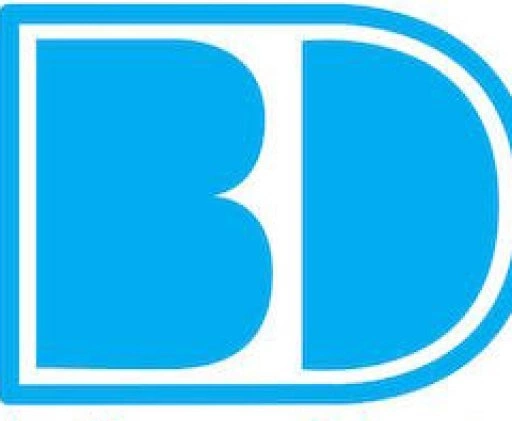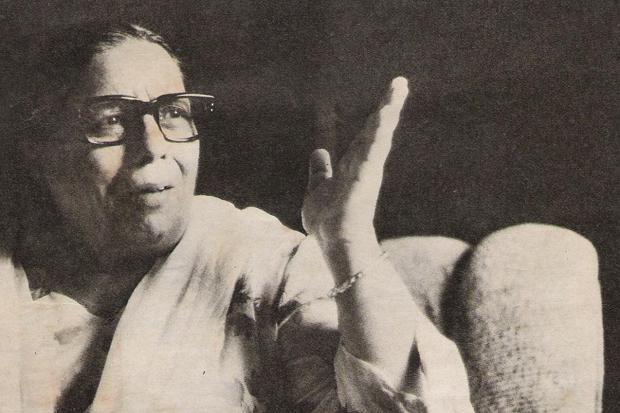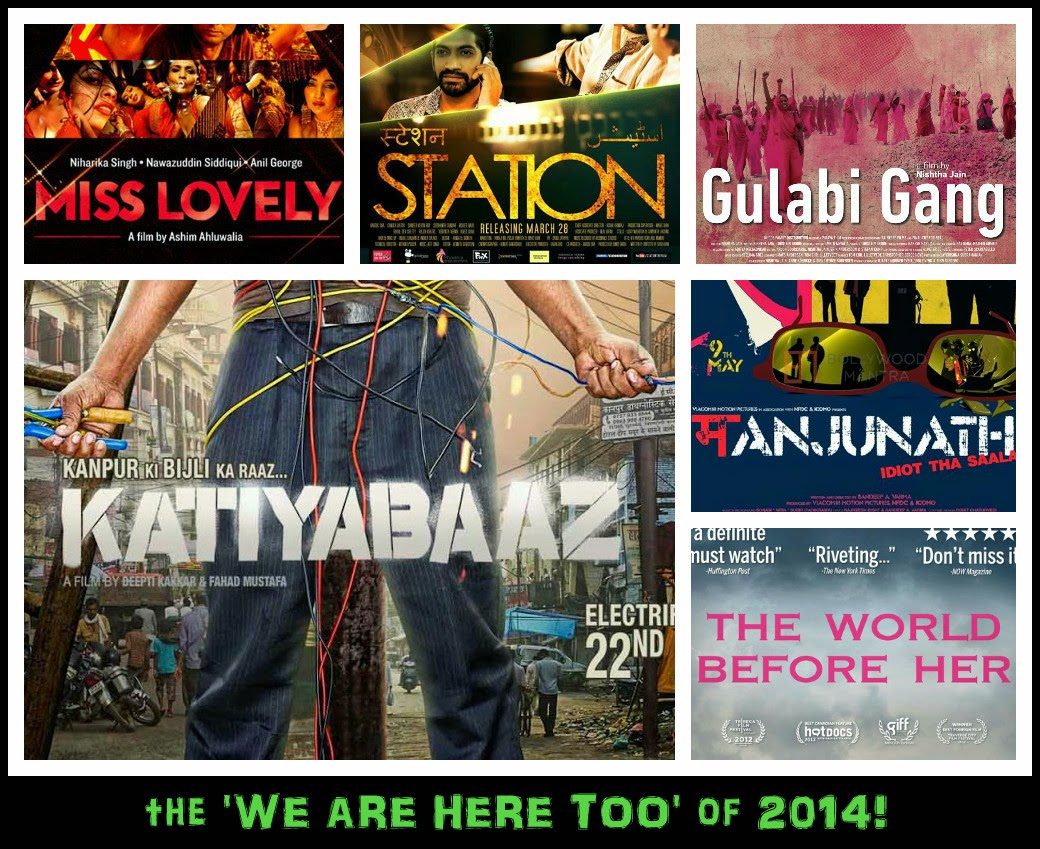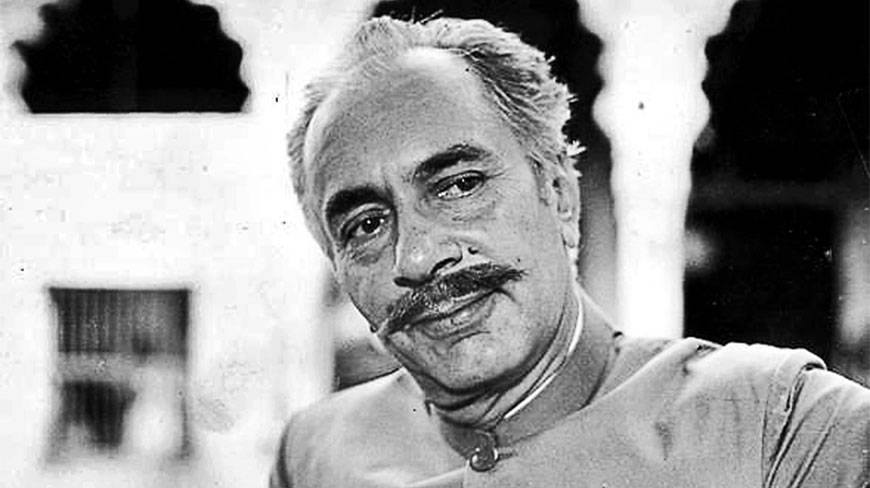When I first began to research the songs of Shamshad Begum in order to do a post, I reckoned it would be very easy – after all, I knew her popular songs and since I had grown up listening to her, most of her songs were at least familiar to my ears. However, I was in for a surprise. Like many others, I’d also brought into the story that OP Nayyar and Naushad were the two music directors who used her voice the most. Until, research threw up the interesting fact that she had sung the most number of songs for C Ramchandra, and not Nayyar Saab. It was also interesting to note that she seemed to have sung for every music director of note, and many who were relatively unknown. I listed 15 of them in my previous post on Shamshad; but I had many, many more.
This is the same issue that cropped up when I was listing her duets. She seems to have sung duets with *every* male singer of the era, and while she sang the most number of duets with Mohammed Rafi, she has also sung with every other female singer spanning two decades from Zohrabai Ambalewali and Amirbai Karnataki to Noorjehan, Suraiyya, Lata, Asha, Geeta, Rajkumari… the list goes on.
In my previous post, I winnowed the list down by sticking to one song per composer; this time, I’m sticking to one song per co-artiste. Otherwise, the plethora of choices that confronted me when it came to Shamshad-Rafi, Shamshad-Geeta, Shamshad-Lata, or Shamshad-Asha duets were more than enough to fill a dozen posts by themselves.
Here, in chronological order, are 15 songs, with 15 different co-artistes — both men, and women. There are some unusual finds here — like GM Durrani, for instance, or Motilal.
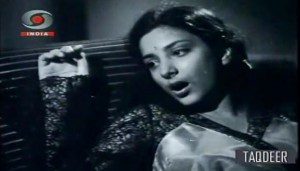 1. Aap kyun aayenge (with Motilal)
1. Aap kyun aayenge (with Motilal)
Taqdeer (1943)
Music: Rafiq Ghaznavi
Lyrics: Mehul Qadri
If it hadn’t been for Mehboob Khan, the Hindi film industry would never have known Shamshad Begum. Already a well-known name in her hometown, Lahore, then the hub of the film industry, she didn’t want to move to Bombay. It was Mehboob Khan who coaxed her into moving. He also gave in to her father’s demands that she not be photographed, that he provide her with a house and car – all of which, Mehboob Khan fulfilled. The movie was Taqdeer, the year, 1942. It was a triumph of sorts – Shamshad came, sang, and conquered. The film was the ‘adult’ debut of Nargis, born Fatima Rashid, and already famous as child actor Baby Rani. She was 13 years old. Her hero? Motilal, older by more than 20 years.
2. 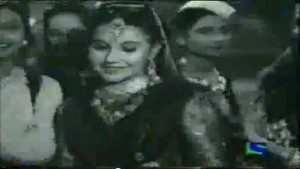 Gori chali piya ke desh (with Zohrabai Ambalewali)
Gori chali piya ke desh (with Zohrabai Ambalewali)
Shama (1946)
Music: Ghulam Haider
Lyrics: Shums Lucknowi
If ever Shamshad Begum had a mentor, it was Master Ghulam Haider. He knew her from her Lahore days; in fact, was the man who ‘discovered’ her, and convinced her father, a conservative man, to let her sing. Her father finally agreed, but not before imposing many conditions that his obedient daughter followed. Khazanchi (1941) was her first Hindi ‘film’ recording. Ghulam Haider had previously composed music for a Punjabi film called Yamla Jat (1940) in which the young Shamshad sang for the heroine Anjana, while Noor Jehan sang for herself. When Ghulam Haider moved to Bombay in 1944, Shamshad was only too happy to work with him again. Chal Chal Re Naujawan, Humayun, Phool, Bairam Khan and Sharma followed, each one with a a plethora of melodious numbers. He was her ‘Guru’, and until he migrated to Pakistan following the partition, he not only mentored her but closely monitored her career. He and his wife, Umrazia Begum, were very attached to her.
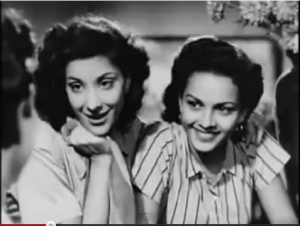 3. Dar na muhobath kar le (with Lata Mangeshkar)
3. Dar na muhobath kar le (with Lata Mangeshkar)
Andaz (1949)
Music: Naushad
Lyrics: Shakeel Badayuni
Lata and Shamshad had sung but a handful of songs together (their duets numbered 28 in all), and if it was C Ramchandra who first got the two together for Khidki, it was Naushad who gave the two some of their most popular duets (the iconic Teri mehfil mein kismet aazmakar from Mughale-e-Azam/1960 and Kisi ke dil mein rehna tha from Babul/1950).
Few people know that Lata had once won a Khazanchi competition – the film’s music was a rage, and in 1941, a competition was held in Pune to see who could sing two songs from the film. Lata won the prize by singing two Shamshad Begum solos from the movie.
Like C Ramchandra moved to Lata, using Shamshad but rarely, and seldom for the ‘heroine’, so also, Naushad began to use Shamshad for either the ‘vamp’ (Nigar in Mughal-e-Azam) or the second lead (Munawar Sultana in Babul. Guess who sings for Nargis?) Here, Shamshad lends voice to Cuckoo, while Lata sings for the heroine, Nargis.
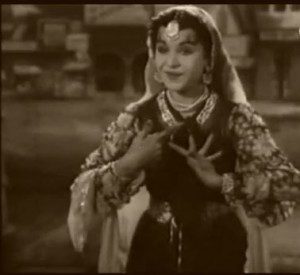 4. O dil waalo dil ka lagaana (with Chitalkar)
4. O dil waalo dil ka lagaana (with Chitalkar)
Patanga (1949)
Music: C Ramchandra
Lyrics: Rajinder Krishen
Shamshad’s collaboration with C Ramchandra began in 1946, and continued for another decade. Apart from Naushad, it was for C Ramchandra that she sang the maximum number of songs (61 songs, 25 films). In fact, she was his favorite singer until Lata Mangeshkar came along. It is well-known that 1949 (and Barsaat) was the year which saw the beginning of the Lata Mangeshkar wave. It is assumed that Lata had a big hand in C Ramchandra’s neglect of his once-favourite singer, but Shamshad Begum has never complained. And since she gave interviews but rarely, there was never any controversy of sorts.
It was for C Ramchandra that she sang her first ‘westernized’ song – the swinging Meri jaan, meri jaan, Sunday ke Sunday in Shehnai (1947). The next year saw the composer bring his current favorite and the new-singer-who-was-to-become-his-muse together, along with singer Mohantara Talpade for a qawwali – Khushiyan manaye kyun na hum from Khidki (1948).
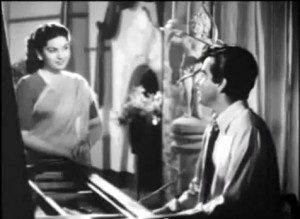 5. Milte hai aankhen dil hua diwana (with Talat Mahmood)
5. Milte hai aankhen dil hua diwana (with Talat Mahmood)
Babul (1950)
Music: Naushad
Lyrics: Shakeel Badayuni
Naushad had entered films as a pianist in composer Mushtaq Hussain’s orchestra; later, composer Khemchand Prakash took him on as his assistant, an act for which Naushad remained grateful. While he got his first break as music director with Prem Nagar (1940), it was Rattan (1944) that propelled him to the big league.
Shamshad Begum was already a ‘star’ when Naushad signed her on to sing for him. Her first song for him was for the film Shah Jehan (1946), where she had two solos; Anokhi Ada, Chandni Raat, Dillagi, Dulari, Babul – all followed in quick succession. She remained his favorite singer after Lata Mangeshkar, and he has openly acknowledged her contribution to his success.
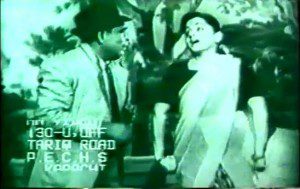 6. Humse nain milana (with Mukesh)
6. Humse nain milana (with Mukesh)
Aankhen (1950)
Music: Madan Mohan
Lyrics: Bharat Vyas
This was Madan Mohan’s debut as a music director in his own right. Until then, he had been a chorus singer with C Ramchandra. When Lata Mangeshkar refused to sing for him, he approached Shamshad. He didn’t even have the money to pay her, but she still sang for him. Aankhen was a big hit, Madan Mohan, and Lata Mangeshkar patched up (he became her rakhi brother) and Madan Mohan never repeated Shamshad as a lead singer ever again, except once, in Shabistan (1951).
This duet is a very frothy number, so unlike the songs that both singers are known for – and therefore, that trumped my favorite (Main bhanwra tu hain phool from Mela). It’s picturised on Yakub and Yashodhara Katjoo (identified by dusted off), and you can catch a glimpse of a very young and very pretty Nalini Jaywant in the balcony. Aankhen also had a rare duet – Madan Mohan himself, singing with Shamshad – Humse na dil ko lagana, which I saw when I was searching for Shamshad Begum’s duets on the Net. I also came across another vintage gem, though; Raj Khosla, yes, director Raj Khosla singing Rail mein jiya mora along with Madan Mohan. The audio quality is abysmal, but that is the only video that remains.
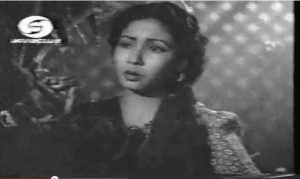 7. Toot gaya hain toot gaya (with Rajkumari and Mohammed Rafi)
7. Toot gaya hain toot gaya (with Rajkumari and Mohammed Rafi)
Magroor (1950)
Music: Sajjad Hussein
Lyrics: Raja Mehdi Ali Khan
Magroor had two music directors, Bulo C Rani and Sajjad Hussein. Sajjad composed only two of the eight songs in this film, leaving me to wonder whether this was one of the films he left incomplete, forcing the producer to sign another music director (as an aside, Bulo C Rani’s score for Magroor is excellent). However, in the two songs that he did compose, he made full use of Shamshad for both Nigar Sultana and Meena Kumari.
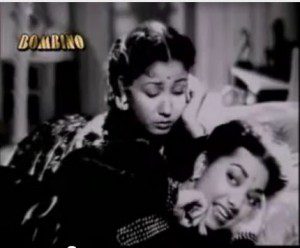 8. Dil le gaya ji (with Suraiya)
8. Dil le gaya ji (with Suraiya)
Sanam (1951)
Music: Husnlal Bhagatram
Lyrics: Qamar Jalalabadi
Suraiya was not a playback singer in the true sense of the word since she sang only for herself. She and Shamshad had collaborated earlier in films like Mirza Ghalib (1947).
Sanam was another film where a very young Meena Kumari plays second-fiddle, this time to leading lady Suraiya; she’s busy teasing her cousin Suraiya about her love, while Suraiya is dreaming of both reel-and-real-life love Dev Anand. The song begins with Meena teasing Suraiya about Dev Anand, and ends with her teasing Gope about his less-than-busy legal career.
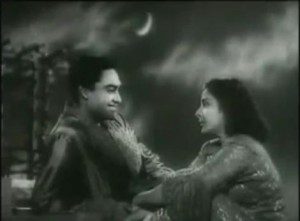 9. Nazar phero na humse (with GM Durrani)
9. Nazar phero na humse (with GM Durrani)
Deedar (1951)
Music: Naushad
Lyrics: Shakeel Badayuni
This one ran a close race with another GM Durrani-Shamshad number (the fun-and-frolic filled Pagdi pehenke turredaar akadta kyun hain from Madhosh / 1951 / Madan Mohan / Raja Mehdi Ali Khan); I chose this because a) it had Ashok Kumar singing! and b) this list was beginning to seem like a Shamshad-Meena list.
Deedar was intriguing because it had Ashok Kumar playing the third angle to a romantic triangle, and because, for the second time after Andaz, Dilip Kumar was reprising his role as the lover for whom the heroine has no feelings whatsoever.
This is a sweet romantic duet between husband and wife before fate intervenes in the form of an obsessed Dileep Kumar. This was the only other song that Shamshad had in this film, the other being Bachpan ke din bhula na dena – where she sang for the young Dilip while Lata was the young Nargis’s voice. It was a sign of things to come, perhaps.
10. Door nagariya tore (with Geeta Dutt)
Sapna (1952)
Music: Shyam Babu Pathak
Lyrics: ?
Shamshad first sang with Geeta Dutt in a group song along with Munawar Sultana and Naseem Banu (Bairam Khan/1946). Their first duet was Yeh haseenon ke mele albele in 1947, for a film called Bhookh (Anil Biswas). In a few short years, the two singers chalked up around twenty duets, until music directors who had sworn by Shamshad, and in many cases, been helped by her in their initial stages, hitched their wagon to the new star on the horizon – Lata Mangeshkar. In fact, OP Nayyar, who had initially used both these singers, never composed a duet with them. He was perhaps the only composer to admit that it was his emotional involvement with Asha Bhonsle that led him to neglect both Shamshad and Geeta.
A 1949 duet with Geeta, Mera dil tadpa kar kahaan gaya (Shabnam, SD Burman) ran this one a close second, and it had a video. Lovely song, Paro, Kamini Kaushal and Dilip Kumar with a moustache – what more can you ask for? 🙂 Also in the running was Jiya ka diya piya from Sunehre Din/1949 (Gyan Dutt / DN Madhok), picturised on Rehana and another dancer.
11. La de mohe balma aasmani choodiya (with Mohammed Rafi)
Rail ka Dibba (1953)
Music: Ghulam Mohammed
Lyrics: Shakeel Badayuni
When I first came across this song, my husband brought it to my attention that while Shamshad Begum effortlessly sang the 8-10 lines at double the tempo, Mohammed Rafi had to take a breath in between. (Rafi! I was stunned.) More research brought up an interview with Shamshad where she said that while she recorded the song in a single take, Rafi couldn’t get it right even after five takes. When the song was finally okayed, he came to her and said “aapaji, maan gaye aapko”.*
(Rafi’s portion of the song starts at around 0.55 seconds – at 1.00, he takes an audible breath. Shamshad’s portion, where she sings at the same tempo, comes around 1.52 – she doesn’t take a breath until the 10 lines are complete.)
If anecdotal evidence is proof, then this was a collaboration not only between two great singers but two genuinely good people. Between them, they accounted for around 160 duets. While Leke pehla pehla pyar from C.I.D/1956 (OP Nayyar / Majrooh Sultanpuri) is probably the most famous of their duets, two others are very, very close to my heart: Bheega bheega pyar ka sama from Sawan/1959 (Hansraj Behl / Prem Dhawan) and Solah baras ki bhayee umariya from Aag/1948 (Ram Ganguly / Majrooh Sultanpuri). In fact, if it weren’t for that interesting tidbit about Mohammed Rafi, I would probably have chosen the song from Aag, simply for its picturisation.
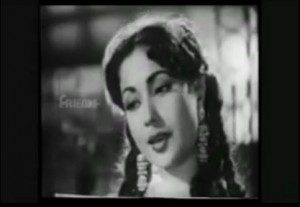 12. Mere neendon mein tum (with Kishore Kumar)
12. Mere neendon mein tum (with Kishore Kumar)
Naya Andaz (1956)
Music: OP Nayyar
Lyrics: Jaan Nisaar Akhtar
I know, I know, yet another Meena Kumari song. What can I do? It’s such a lovely romantic number and Meena looks so beautiful, and Shamshad and Kishore match each other so beautifully…
Shamshad remembers Kishore Kumar as a young disheveled lad, who was always nice to her, and full of life. He would ask her if he would ever be as successful as his older brother; “…you can see how successful he became.”**
13. Desi kya bidesi (with Manna Dey)
Lal Batti (1957)
Music: Salil Choudhary
Lyrics: Majrooh Sultanpuri
The second of the three songs that Shamshad Begum sang for Salil Choudhary. It is frustrating not to find any videos for this film, especially since this song was (apparently) picturised on Balraj Sahni and Sulochana! IMDB tells me that Balraj Sahni co-directed this movie, which also co-starred Mala Sinha and Shashikala.
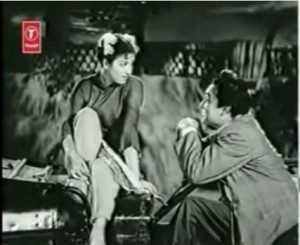 14. Nigahon ka ishaara hain (with Asha Bhonsle)
14. Nigahon ka ishaara hain (with Asha Bhonsle)
Night Club (1958)
Music: Madan Mohan
Lyrics: Majrooh Sultanpuri
Shamshad and Asha sang 54 duets together. I know that the most famous Shamshad-Asha duets are Reshmi kurta salwar jaali ka (Naya Daur /1957) and Kajra muhobatwala (Kismat/1968) both composed by OP Nayyar, but this is a much older duet from a relatively unknown movie.
Another song ran this a close second, and I must confess it is because of its picturisation – Allah kare main bhi dulhan ban jaoon from a 1963 movie called Kaun Apna Kaun Paraya. After all, who can resist a qawwali and characters called Champakali Dilliwali and Anarkali Calcuttewali? There is also a beautiful Waheeda to add to the attraction. In fact, now I’m wondering why I chose this song, with a be-ribboned simpering Kamini Kaushal in two pony-tails (that’s the first thing that strikes you!). Hmpf, never mind. The Madan Mohan composition is far superior to the other, and I’ll take the music over the picturisation any day.
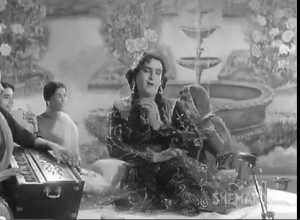 15. Chali chali kaisi hawa (with Usha Mangeshkar)
15. Chali chali kaisi hawa (with Usha Mangeshkar)
Bluff Master (1963)
Music: Kalyanji-Anandji
Lyrics: Rajinder Krishen
Question 1: How can I do a post without bringing in Shammi Kapoor? Question 2: How can such a handsome man look so ugly? Question 3: Why does he have four singers (Mohammed Rafi, Mukesh, Hemant Kumar, Shamshad Begum) singing playback for him in the movie? Question 4: Why do I ask rhetorical questions?
In Manmohan Desai’s complicated tale of a conman who falls in love, Shammi does everything, including a dress in drag. This was one of the songs that harvey had in his post on Bollywood men in drag; and it really is a song I think needs to be heard and not seen. As much as I love Shammi, it truly is unbearable to see him in this avatar.
And now because I’m horrid and mean, here is one song that will frighten the living daylights out of you. It’s here only because I didn’t find another Mahendra Kapoor-Shamshad Begum duet. It’s from a 1970 movie called Raton ka Raja; music is by RD Burman and lyrics by Majrooh, but watch at your own peril.
Any mention of Shamshad Begum by her contemporaries or the music directors she worked with is replete with a nod to her professionalism (she’s never canceled a schedule), her generosity of spirit and her essential good nature. Despite that, it took until 2009 for the Government of India to recognize her contribution to the entertainment arts. She is supposed to have said daer aaye durust aaye when she heard of the honor.
It is perhaps a mark of how much of a private person she was that very little is known about her or her songs. So much so that they have killed her off a couple of times – once, in 1998, when the other Shamshad Begum, Saira Banu’s grandmother died, (and it’s a crying shame that went into print without being double-checked); and the other, when, on the Internet, people avow that she died in 2007 – and even provide the place – a hospital in Lahore, Pakistan. This, when she was alive and well in Bombay (unless that was her ghost in the photograph up there?)… Is she alive today? I think so. But I cannot find any recent articles about her, and cannot say for sure that she is. And that is a sad thing.
© Anuradha Warrier
Written By: Anuradha Warrier, is a writer, editor, film, and music buff. She writes for pleasure, edits for a living, and indulges in watching films, listening to music, and writing about both on her blog Conversations Over Chai as and when time permits.
DISCLAIMER: The views expressed are solely of the author and Bollywoodirect.com do not necessarily subscribe to it. Bollywoodirect.com shall not be responsible for any damage caused to any person/organisation directly or indirectly.
References
The following sites have been of great help in collating the information for these two posts:
- Cineplot.com for statistics, years films were released, music directors, lyricists and so on, and corroboration of the admittedly scarce information about Shamshad Begum.
- Shamshad Begum’s remark about Mohammed Rafi was from an interview conducted by Rachana Dubey. I cannot find the original, but this excerpt has been mentioned in many places, including here.
- **This is strange because there are two sources for this statement, in two different interviews by two different people. I do not know which interview came first.
- smriti.com not only helped me with names of lyricists for various songs, it also helped me recall many of my old favorites.
- www.shamshadbegum.com which is a labor of love, and had some very interesting snippets of information.
Others:
- Manohar Iyer has a lovely article on how he met the legendary artist.
